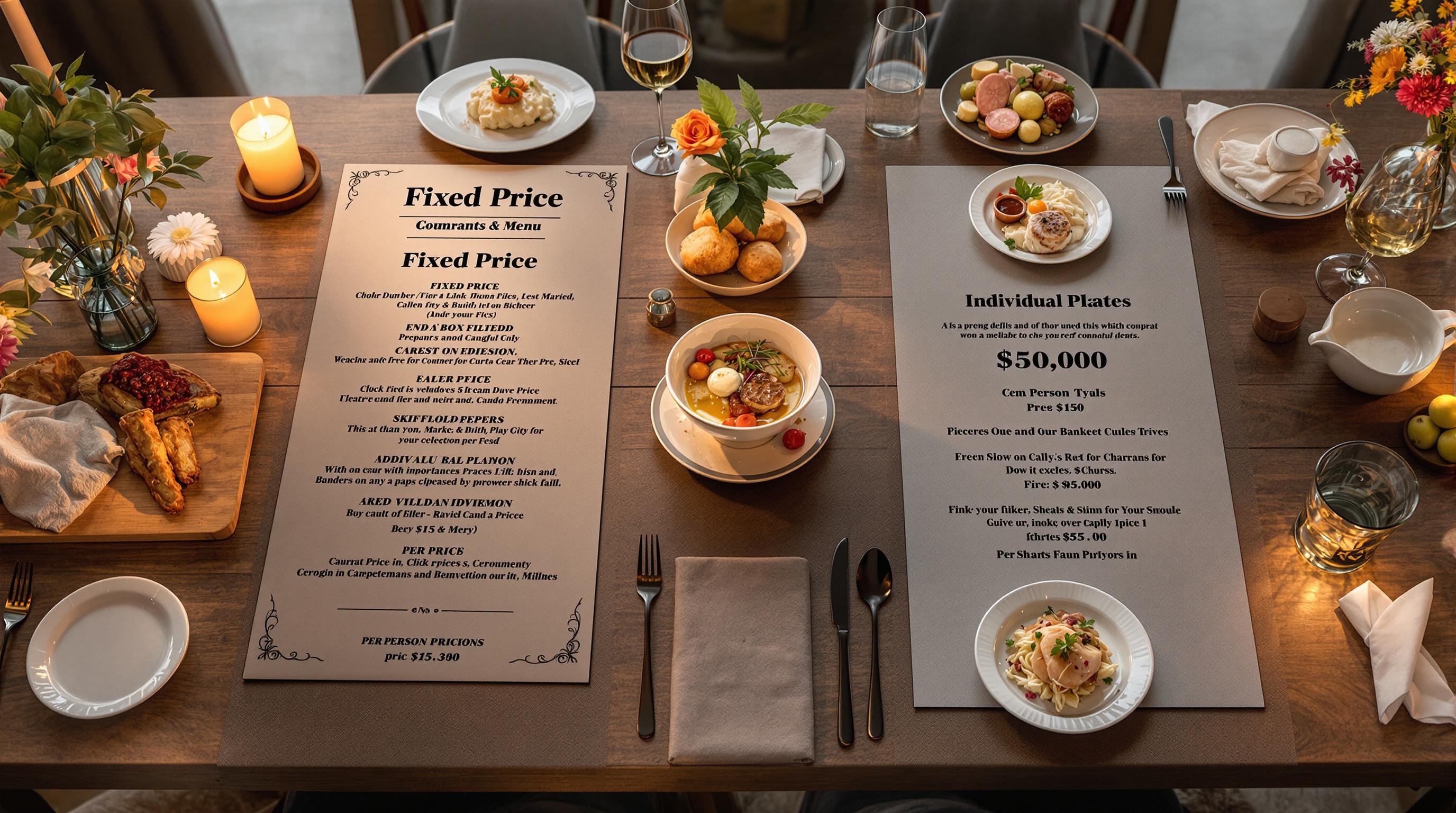Dealing with customer complaints in a steakhouse is about turning problems into opportunities to improve service and build loyalty. Here’s how to do it:
- Respond Quickly: Acknowledge issues immediately and act fast to resolve them.
- Train Staff: Teach employees to listen actively, show empathy, and handle complaints confidently.
- Empower Employees: Give staff the authority to fix common issues on the spot.
- Follow Up: Track complaints, document resolutions, and follow up with customers to rebuild trust.
- Use Feedback: Regularly review complaints, identify patterns, and update procedures to prevent recurring problems.
Quick Solutions Guide
| Complaint Type | Initial Action | Backup Plan | Escalation Criteria |
|---|---|---|---|
| Cooking Temperature | Replace the dish | Discount or alternative | If unresolved after attempts |
| Service Delays | Offer a free appetizer | Discount on the bill | If delays persist |
| Food Quality | Prepare a new dish | Full compensation | If multiple items are affected |
Steps of Handling Guest Complaints in Fine Dining Restaurants
Staff Training for Complaint Response
Training your staff to handle complaints effectively can turn negative experiences into chances for quick fixes and lasting improvements. Employees need to listen carefully, understand the issue, and respond in a way that shows guests their concerns are taken seriously.
How to Listen Actively
To truly listen and understand, staff should:
- Maintain open and attentive body language.
- Pay attention to details and summarize key points to confirm understanding.
- Ask follow-up questions when clarification is needed.
Adding empathy to these practices takes communication to the next level.
Showing Empathy in Customer Service
Strong customer relationships are built on empathy. Encourage your team to:
- Acknowledge and validate the guest’s emotions.
- Show sincere concern for their experience.
- Concentrate on finding solutions instead of assigning fault.
Role-playing scenarios can help employees practice these techniques, boosting their confidence when dealing with real-life situations.
Staff Authority in Problem-Solving
Once your team is well-trained, the next step is giving them the authority to address guest concerns directly. When staff can handle issues without waiting for approval, it speeds up resolutions and improves the guest experience. Combine this authority with their skills in listening and empathy for the best results.
Quick Solutions Guide
Provide your team with a clear guide for handling common situations. This helps them respond confidently and consistently. For example, they can:
- Offer a free appetizer or dessert for delays in service
- Replace a steak if it’s not cooked to the guest’s preference
- Apply discounts for issues with specific items
- Compensate a full meal in cases of food safety concerns
Here’s an example of a solutions matrix your team can use for quick reference:
| Complaint Type | Initial Resolution | Secondary Resolution | Escalation Criteria |
|---|---|---|---|
| Cooking Temperature | Replace the steak | Offer a discount or alternative dish | Escalate if the problem persists after further attempts |
| Service Delay | Offer a complimentary appetizer | Provide a discount on the bill | Escalate if delays go beyond acceptable limits |
| Quality Issues | Prepare a new dish | Offer full compensation | Escalate if multiple items are affected |
| Food Temperature | Reheat or replace the dish | Offer full compensation | Escalate if the issue remains unresolved |
| Cleanliness | Address the concern immediately | Provide a discount on the bill | Escalate if health or safety concerns arise |
When to Escalate to Management
Some situations require management involvement. Make sure your team knows when to escalate, such as:
- When a guest specifically asks to speak to a manager
- If the issue involves food safety, allergies, or major quality concerns
- When multiple tables report the same problem
- If the solution needed is beyond their authority
- If a guest becomes hostile or mentions legal action
- When complaints involve employee behavior
Set clear guidelines for these scenarios and ensure staff can quickly reach management. Tools like service tablets or designated hand signals can help streamline communication during busy times.
sbb-itb-e6be165
After-Complaint Customer Care
Keeping track of complaints and following up quickly is key to resolving problems and earning customer loyalty. A well-organized system for handling complaints ensures issues are addressed effectively and turns negative experiences into positive ones.
Complaint Record System
Document complaints in a clear and consistent way to spot trends and address recurring issues. Key details to log include:
- Date and time of the incident
- Table number and server name
- Nature of the complaint
- Resolution provided
- Customer contact information
- Follow-up status
| Category | Key Details | Actions Taken | Resolution Status |
|---|---|---|---|
| Service Issues | Server name, wait time, specific concern | Initial response, compensation | Open/Resolved/Followed-up |
| Food Quality | Dish name, cooking details, issue | Notify kitchen, replacement info | Open/Resolved/Followed-up |
| Environment | Location in restaurant, concern type | Quick fixes, long-term solutions | Open/Resolved/Followed-up |
| Special Events | Event type, guest count, specific issues | Compensation, manager actions | Open/Resolved/Followed-up |
Go over these records weekly with your management team to:
- Spot areas where staff training is needed
- Adjust procedures to prevent similar issues
- Evaluate how well problems are being resolved
- Track trends in customer satisfaction
Customer Follow-up Methods
Choose follow-up approaches based on how serious the complaint is:
For minor issues:
- Send a personalized email thanking the guest for their feedback.
- Share details about changes made based on their input.
- Offer a small gesture, like a complimentary appetizer for their next visit.
For major complaints:
- Have a manager personally call the guest to discuss the issue.
- Send a handwritten note acknowledging their experience.
- Provide a larger gesture, such as a gift card or an exclusive dining experience.
Keep track of whether guests return, how they respond to your follow-ups, and overall retention rates to measure the effectiveness of your efforts. Always document follow-up actions consistently.
Using Feedback to Improve Service
Transform complaints into opportunities for growth by implementing feedback systems and recognizing staff efforts to ensure continuous improvement.
Team Feedback Meetings
Set up weekly meetings to review complaints and create actionable solutions. Here's how to structure these meetings for maximum impact:
1. Review Recent Complaints
Begin by analyzing the previous week's complaints. Share clear data on complaint types, how often they occurred, and resolution rates. This approach helps pinpoint areas that need immediate attention.
2. Analyze Root Causes
Encourage all team members to contribute to identifying the underlying causes of recurring issues. Develop action plans that address the root problems rather than just the surface symptoms.
| Issue Category | Root Cause Analysis | Action Plan | Timeline |
|---|---|---|---|
| Food Temperature | Delays from kitchen to table | Introduce an expeditor role | 1 week |
| Wait Times | Staffing shortages at peak hours | Revise the scheduling matrix | 2 weeks |
| Special Requests | Poor communication channels | Install a kitchen display system | 1 month |
Combine these insights with your recognition program to reinforce positive changes.
Staff Recognition Program
Encourage and motivate your team with a structured recognition program:
Monthly Awards
- Service Recovery Star: For employees who turn negative experiences into positive outcomes.
- Problem Solver of the Month: For innovative solutions to customer challenges.
- Guest Satisfaction Champion: Based on positive follow-up feedback from guests.
Incentive Structure
- Reward exceptional efforts with gift cards ranging from $25 to $100.
- Allow top performers to choose preferred shifts.
- Include resolution performance metrics in promotion decisions.
Measure the success of your recognition program by tracking:
- Customer return rates after complaints.
- Positive feedback that mentions specific staff members.
- A decrease in recurring complaints of the same type.
Conclusion: Turning Complaints into Positive Outcomes
By using the strategies discussed earlier, businesses can transform complaints into opportunities for growth and stronger customer relationships. Handling complaints effectively not only resolves immediate issues but also fosters long-term loyalty and improves service quality. When steakhouses adopt structured feedback systems and empower their teams, they create an environment focused on constant improvement.
A well-designed complaint-handling process minimizes recurring problems, boosts staff confidence, enhances customer trust, and improves overall operations. With consistent feedback analysis and a focus on employee empowerment, every complaint becomes a chance to make meaningful changes.
Here are some ways to turn complaints into actionable outcomes:
- Analyze feedback regularly to identify patterns
- Invest in ongoing staff training and skill development
- Maintain clear and open internal communication
- Celebrate and recognize outstanding complaint resolution efforts
Each resolved complaint is a chance to build stronger customer connections and improve service. Using these insights to refine operations shows a commitment to quality and helps secure customer loyalty.
The secret to success is treating complaints as opportunities rather than setbacks. When employees feel supported and confident in addressing issues, they contribute to the restaurant's ongoing journey toward better service.
Adopt these practices to turn challenges into lasting improvements.


